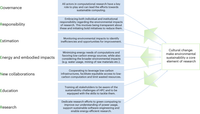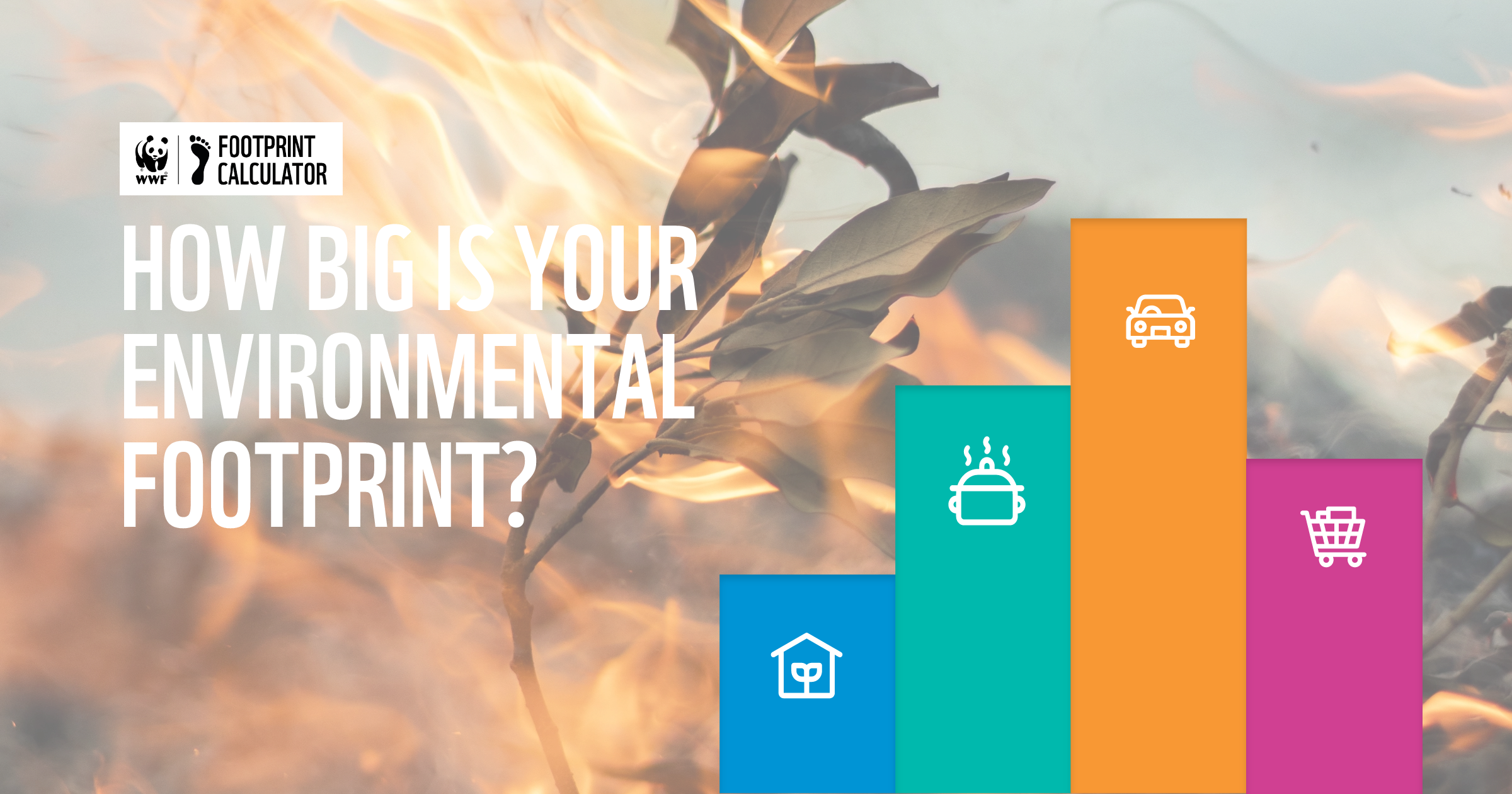Durchsuchen Sie die Webergebnisse zu dieser Domain.

Mariette, J. et al. An open-source tool to assess the carbon footprint of research. Environ. Res. Infrastruct. Sustain. 2, 035008 (2022). ... Murray, D. S. et al. The environmental responsibility framework: a toolbox for recognizing and promoting ecologically conscious research.
Lannelongue, L., Grealey, J., Bateman, A. & Inouye, M. Ten simple rules to make your computing more environmentally sustainable. PLoS Comput. Biol. 17, e1009324 (2021). ... Trébaol, T. CUMULATOR—a Tool to Quantify and Report the Carbon Footprint of Machine Learning Computations and Communication in Academia and Healthcare (École Polytechnique Fédérale de Lausanne, 2020).The carbon footprint of computational sciences is substantial, but there is an immense opportunity to lead the way towards sustainable research. In this Perspective the authors lay some fundamental principles to transform computational science into an exemplar of broad societal impact and sustainability.The carbon footprint of scientific computing is substantial, but environmentally sustainable computational science (ESCS) is a nascent field with many opportunities to thrive. To realize the immense green opportunities and continued, yet sustainable, growth of computer science, we must take a coordinated approach to our current challenges, including greater awareness and transparency, improved estimation and wider reporting of environmental impacts.Nature Computational Science - The carbon footprint of computational sciences is substantial, but there is an immense opportunity to lead the way towards sustainable research. In this Perspective...
This applies especially to large projects that may damage delicate ecosystems. The Global Footprint Network is a non-profit, multinational organization that develops and promotes tools for forwarding sustainability, which basically works to remove the deficit between the Earth’s ecological ...
This applies especially to large projects that may damage delicate ecosystems. The Global Footprint Network is a non-profit, multinational organization that develops and promotes tools for forwarding sustainability, which basically works to remove the deficit between the Earth’s ecological footprint and its biocapacity.Calculate your carbon footprint in seconds! Carbon footprint calculator gives custom tips to reduce YOUR emissions from energy, flights, diet and more.Calculating your footprint and understanding your ecological footprint are crucial steps in lowering your carbon emissions. It means taking responsibility for the ecological impact your daily life is having–the ecological footprint we’re all contributing to.Take responsibility. Act with us now by calculating your footprint above. Each year, we produce more carbon emissions that the world can handle. Scientists call this the “Earth Overshoot Day.” It happens every year. (Check out the definition of ecological footprint below.)

With humanity currently in overshoot, societal changes must be enacted to return to sustainable levels. While either a country’s ecological footprint or population size could be altered to achieve the necessary level, combined efforts on both fronts would be most effective.
A sustainable population corresponds to the total human population that the planet can support without diminishing the health of the biosphere and its ability to support humans, in the same numbers and at the same standard of living, into the future. To assess this population, several calculation methods can be used, or even combined. In this contribution, we will confine ourselves to a single analytical element, the ecological footprint, which has the advantage of synthesising many ecological impacts caused by human activities.The concept of the footprint was initiated and refined by the Global Footprint Network (GFN) and is now the most widely used indicator of general sustainability in the environmental community and well beyond, since some countries have incorporated it into their national accounts. According to the GFN definition, the ecological footprint measures the surface area of land required to produce the resources a population consumes and to absorb the waste it generates.[…] Garnier a publié un article (en anglais) sur le site de l’Overpopulation Project. Cet article : Ecological Footprint and Sustainable Population, reprenant les éléments de certaines de ses conférences offre une réflexion sur ce qui serait […]Countries' ecological footprint and population size must change to self-sufficiency levels to ensure a sustainable world future.
Because both these indicators apply ... to track sustainable development progress at any scale. The United Nations considers an HDI greater than 0.8 to be “very high,” and 0.7 as “high” human development. Universally replicable well-being requires an average Ecological Footprint less than ...
Because both these indicators apply to various geographic scales (globe, region, country, community), this framework can be used to track sustainable development progress at any scale. The United Nations considers an HDI greater than 0.8 to be “very high,” and 0.7 as “high” human development. Universally replicable well-being requires an average Ecological Footprint less than world-average biocapacity.As shown in the figure above, measuring HDI and the Ecological Footprint reveals that very few countries come close to achieving these basic conditions for global sustainable development (the blue quadrant). This is despite the growing adoption of the Sustainable Development Goals and other policies that strive to increase well-being without eroding humanity’s long-term resilience.Kate Raworth has playfully pushed this thinking, advocating for a “safe and just operating space.” She depicts the sustainable development challenge as a two-dimensional doughnut, the inner edge representing the minimal social foundation and the outer edge of the doughnut the upper ecological ceiling (Raworth 2017). Therefore, the “flesh” of the doughnut corresponds to the “safe and just operating space,” the same space depicted as the blue “global sustainable development” box in the lower right corner of the HDI-Footprint diagram.At the local level, Global Footprint Network piloted a tool help international development organizations and social entrepreneurs assess whether their projects are improving human well-being in an environmentally sustainable way. We assessed human well-being and resource security at a micro scale to help our partners better understand development progress. Instead of measuring impact by documenting the implementation of specific strategies, the project used HDI and Ecological Footprint calculations to take a step back and ask, “Is this project improving people’s lives?
Earthday.net, with its theme of ... and study the concept of ecological footprint. Together with Redefining Progress, it measures how much is needed to produce the resources we consume and dispose of our waste. EF: A measure of sustainability An interesting way to look at ...
Earthday.net, with its theme of 'Protecting our home', offers a number of resources to understand and study the concept of ecological footprint. Together with Redefining Progress, it measures how much is needed to produce the resources we consume and dispose of our waste. EF: A measure of sustainability An interesting way to look at ecological footprint is how much nations consume versus how much they actually have.The simplest way to define ecological footprint would be to call it the impact of human activities measured in terms of the area of biologically productive land and water required to produce the goods consumed and to assimilate the wastes generated.Another detailed look at the concept and a ranking of countries can be found here. What is your Ecological Footprint? Everyone of us has an ecological footprint. To find out how far you have put your foot in it, try this site, irrespective of your geographical location.Ecological Footprint of 52 countries Another way to measure ecological footprint is a country-wise ranking. Fifty-two nations are ranked here depending on how they fare in this department.


Find out what the carbon footprint is, how it’s calculated, and learn about the negative effects of greenhouse gas emissions on the environment, and global initiatives to curb it.
An environmental footprint is an international sustainability indicator that, as defined by its authors, measures "the area of biologically productive land needed to produce the resources consumed and assimilate the waste generated." An ecological footprint is used to calculate the degree of ...
An environmental footprint is an international sustainability indicator that, as defined by its authors, measures "the area of biologically productive land needed to produce the resources consumed and assimilate the waste generated." An ecological footprint is used to calculate the degree of impact our lifestyle has on the environment.Before calculating it, it's important to note that to measure a sustainable footprint four factors have to be taken into account: Materials and energy are needed to produce any good or service · Environmental systems as required to absorb the waste generated in the production processes of those final goods or services · The use of infrastructure and equipment reduces the acres of surface land that could be allocated to productive ecosystemsTherefore, the commitment of all members of society, whether it be as a group or individually, is fundamental. Improving the way we produce, choose, and consume is the first step in reducing our ecological footprint. By consuming responsibly and putting more sustainable habits into practice, we can reduce it considerably.Another sustainable mobility option is a temporary car rental service known as carsharing, which makes it possible to rent a car by the minute to travel short distances · Use the heating and air conditioning responsibly as it's an excellent way to cut your ecological footprint, while maintaining the recommended temperature in buildings between 19-2ºC in winter and 23-25ºC in summer

Lina A. Khaddour, ... Jacob K. Dodoo, in Encyclopedia of Sustainable Technologies (Second Edition), 2024 · The ecological footprint is one way of measuring sustainability on a city level. It was introduced in 1997 as the first systematic framework for calculating biocapacity and waste generated ...
Lina A. Khaddour, ... Jacob K. Dodoo, in Encyclopedia of Sustainable Technologies (Second Edition), 2024 · The ecological footprint is one way of measuring sustainability on a city level. It was introduced in 1997 as the first systematic framework for calculating biocapacity and waste generated in cities (Borucke et al., 2013).Policy makers have an important role to play to facilitate public acceptance towards naturalistic habitats in cities by reducing cities ecological footprints, promoting sustainable green economies, resource efficiency and reduce waste.Malin Song, ... Xianyou Pan, in Sustainable Marine Resource Utilization in China, 2020 · The modified marine ecological footprint model is used to measure the marine ecological footprint in coastal areas and the degree of coordination between marine economic growth and marine resource utilization in coastal areas is evaluated using the decoupling model.The Ecological Footprint (EF) is recognised as the first of the footprint tools (Wackernagel & Rees, 1996). It was developed in the 1990s as one of the first measures of sustainability and gained popularity due to the fact that the footprint concept was relatable, tangible, and meaningful.
This reporting framework for the CSRD is known as the European Sustainability Reporting Standards (ESRS). Fundamentally, the principles by which Global Footprint Network has applied the Ecological Footprint to companies is aligned with the basis of ESRS sustainability disclosures (ESRS1 Objective ...
This reporting framework for the CSRD is known as the European Sustainability Reporting Standards (ESRS). Fundamentally, the principles by which Global Footprint Network has applied the Ecological Footprint to companies is aligned with the basis of ESRS sustainability disclosures (ESRS1 Objective 3.3 Double Materiality as the basis for sustainability disclosures) – in other words, identifying risks and opportunities from both an impact materiality and a financial materiality perspective.Understanding the sustainability context we operate in, from the global context to sector and product specific contexts, assessing the risks and opportunities associated with the context of foreseeable climate change and sustainability scenarios has been at the core of how Global Footprint Network has evaluated the overshoot impact of companies. While sustainability reporting is broader, Ecological Footprint accounting addresses very specific, observable questions, which as explained here, are also fundamental.Narrative alignment – while a significant effort will be required to understand and prepare the data for reporting, the majority of reporting “data points” for the ESRS will be done in narrative format (Download efrag.org), thus, Ecological Footprint, and the context it provides by identifying clear ecological thresholds and resource balances, can serve as a unifying context for such sustainability reporting.Ecological Footprint accounts are relevant to and practical for many of the environmental dimensions proposed by the European Sustainability Reporting Standards (ESRS). This summary provides the details.

Eating, travelling, heating your home… What's the carbon footprint of these activities and how can we make more climate-friendly choices?
There are different online solutions to help you estimate your carbon footprint. Small changes can make a big difference in the long run, for example when it comes to transportation, food, clothing, waste, etc. Here are some tips: ... Buy responsibly-made clothes, e.g. made from recycled material or with an eco-labelWhen you drive your car, buy a pair of sneakers or grill a steak, you contribute to the emission of carbon dioxide and other greenhouse gases into the atmosphere. It’s your carbon footprint. Many countries, institutions and companies have committed to reduce their emissions while the EU has even set the objective of being “climate neutral” by 2050.As an individual, you can also estimate your carbon footprint and reduce it.Greenhouse gases are emitted through the production and consumption of goods and services. Carbon footprint is a concept used to quantify the impact of an activity, a person or a country on climate change.
More specifically, the ecological footprint measures the amount of “biologically productive” land or water that enables the population to sustain itself. This measurement takes into account the resources a population needs to (1) produce goods and (2) “assimilate,” or clean up, its waste.
Sustainability for All. ... It is a measure of gauging human dependence on natural resources. ... Alane Lim is a materials science researcher at Northwestern University's Huang Lab. She holds a Ph.D. in materials science and engineering. ... Ecological footprint is a method of gauging humans’ dependence on natural resources by calculating how much of the environment is needed to sustain a particular lifestyle.The ecological footprint is one way of measuring sustainability, which refers to the ability of a population to support itself in the present without compromising that ability for the future. Environmental sustainability occurs when a population can support a particular lifestyle indefinitely while still meeting the demands placed on an environment.It calculates how much of the environment is needed to sustain a particular lifestyle. The ecological footprint can be calculated for different populations, including individuals, cities, regions, countries, or the entire planet.More specifically, the ecological footprint measures the amount of “biologically productive” land or water that enables the population to sustain itself. This measurement takes into account the resources a population needs to (1) produce goods and (2) “assimilate,” or clean up, its waste.
:max_bytes(150000):strip_icc()/renewable-energy-green-urban-farming-in-hong-kong-china-490580465-5c23d73a46e0fb00012d8b56.jpg)

Our funeral practices have a high carbon footprint. Becca Warner explores how she could plan her own more environmentally-friendly burial.
Highly toxic embalming fluid, such as formaldehyde, is often used, which leaches into the soil alongside heavy metals that harm ecosystems and pollute the water table. And the coffin alone can be responsible for as much as 46kg (101lb) CO2e, depending on the combination of materials used. I spend my days attempting to tread lightly on the planet – recycling cereal boxes, taking the bus, choosing tofu over steak. The idea that my death will necessitate one final, poisonous act is hard to stomach. I am resolved to find a more sustainable option.These options offer a kind of eco-novelty: what's a more fitting end for an ocean lover than to rest among the reefs or for a forest fanatic to "transform" into a tree after their death? The only problem is that however sustainable the urn, the ashes deposited in it are the product of carbon-intensive cremation.This involves burying a body without any barriers to decomposition – no embalming fluids, no plastic liners or metal caskets. All of this means zero CO2 emissions, according to a recent analysis conducted by UK sustainability certification company Planet Mark.While the biggest gains in the fight to curb climate change will come from the decisions made by governments and industries, we can all play our part. In Sustainability on a Shoestring, BBC Future explores how each of us can contribute as individuals to reducing carbon emissions by living more sustainably, without breaking the bank.
Calculate your environmental footprint and learn how you can reduce your impact with WWF's Footprint Calculator.


The Sims 4: Eco Lifestyle gives Sims a chance to nurture neighborhoods and improve their Eco Footprint. Here's a complete guide on Eco Footprints.
The Sims 4: Eco Lifestyle is a unique pack to the series and introduces the idea of environmental pollution and preservation to the world. Sims' infrastructure and behavior will directly affect the pollution levels in the surrounding neighborhoods and change the Eco Footprint.The Eco Footprint of an area refers to the pollution level in the air and how it affects the overall environment. Eco Footprints are calculated on how much "green" energy and landscaping are in the lots. Players can check their levels in Build/Buy on the item description, but things like trees, plants, woods, and natural materials have higher green energy.The Eco Footprint can be tracked from the menu where the clock is found. It looks like a foot icon, and when players hover over it, the current Eco Footprint information is listed for whatever neighborhood they are in.To get a Green Eco Footprint, players must make sure they have lots of trees, bushes, and other plants on their lots. Other items with a lot of Green energy are Solar Panels, Dew Collectors, and Wind Turbines, although they often break without upgrades. Most electronics and appliances have Industrial or no Green energy, but they can be upgraded to be eco-friendly.

In this age of increasing environmental ... and making conscious decisions, we can significantly reduce our ecological footprint. This blog aims to provide a comprehensive guide on how you can embrace sustainability in various aspects of...
In this age of increasing environmental awareness, making sustainable choices has become more crucial than ever. By understanding the impact of our actions on the planet and making conscious decisions, we can significantly reduce our ecological footprint. This blog aims to provide a comprehensive guide on how you can embrace sustainability in various aspects ofPrioritize products that come with certifications like “organic,” “fair trade,” or “recyclable.” By investing in items that have a minimal impact on the planet throughout their lifecycle, you contribute to a circular economy where resources are used efficiently and waste is minimized. Remember, every purchase is an opportunity to cast a vote for a more sustainable future. Reducing energy and resource consumption plays a crucial role in minimizing our carbon footprint.Not only are these foods rich in nutrients, but they also have a lower environmental footprint compared to animal products. Additionally, explore local farmers’ markets and community-supported agriculture to access fresh, locally-grown produce. These choices not only support local economies but also help reduce the emissions associated with long-distance food transportation. Remember, the food on your plate is a reflection of the world you want to create. In the digital age, technology can be harnessed for sustainability.sustainability app that can help you track your carbon footprint, find eco-friendly products, and connect with like-minded individuals.
Most of us know or have an idea of what sustainability means theoretically, but do we always practice sustainability in our daily lifestyle? It just takes a few adjustments in our day to make a shift towards sustainability and reduce our ecological footprints on the globe.
We will discuss here what we mean by ecological footprint, and acting responsibly in our daily lives to progress towards a sustainable future. We cannot blame the government or corporations, when corporations and government organizations are here to serve individuals.Ecological footprint simply means the impact of human activities on the globe and the amount of resources necessary to produce the goods and services necessary to support a particular lifestyle, in terms of the area of biologically productive land and water. It also measures how much resources are needed to produce what we need, and what we consume and dispose of. Sustainable Measures has shown that the amount of productive land used by Americans doubled between 1900 to 1950 and doubled again between 1950 and 1995.To achieve sustainability, we need both sustainable technology, and also need to make sustainable choices. (Institution of Mechanical Engineers) Every human produces an individual ecological footprint that is determined largely by the wealth and level of development in the country they live in.I was thinking the other day: Assuming every human had the same ecological footprint, how big can it be while still beeing sustainable?

Canadian ecologist William Rees ... Rees’s supervision. Together, Wackernagel and Rees wrote Our Ecological Footprint (1996), which describes the concept. EF calculations have questioned the sustainability and equity of current consumption and production practice...
Canadian ecologist William Rees created the EF concept, which Swiss urban planner Mathis Wackernagel further developed in his dissertation under Rees’s supervision. Together, Wackernagel and Rees wrote Our Ecological Footprint (1996), which describes the concept. EF calculations have questioned the sustainability and equity of current consumption and production practices.In 2023 the per capita global footprint was 2.6 gha. Since global biocapacity that year was 1.5 gha per person, the EF of humanity overshot Earth’s biocapacity by 1.1 gha. In other words, 1.7 “Earths” would be needed to sustain current resource demands or, alternatively, it takes Earth more than one year and eight months to regenerate what is used in one year. The implication of such “ecological overshoot,” which began in the mid-1970s, is that life-supporting biological resources, such as fisheries, forest resources, rangeland, and agricultural land, are being depleted.Researchers have combined footprint analysis with measures of human development to assess whether countries are on track toward sustainable development—defined as a per capita EF lower than the available per capita biocapacity with a high rating (above 0.8) on the United Nations Human Development Index (HDI). (The HDI is a metric that combines a country’s average life expectancy, educational attainment, and income into a measure of economic and social progress.)Critics also argue that the EF methodology rewards more-intensive production methods that increase yields per unit of land in the short term but might actually be less sustainable in the long run—for example, accelerating land degradation. Similarly, organic farming methods with lower yields than conventional agriculture could appear to have a bigger footprint despite other ecological benefits.

The Ecological Footprint is a resource accounting tool that helps countries manage their ecological resources and secure their future. ... Communities and city planners around the globe use our tools to guide land use and budget decisions, track sustainability progress, and support better ...
Conceived in 1990 by Mathis Wackernagel and William Rees at the University of British Columbia, the Ecological Footprint launched the broader Footprint movement, including the carbon Footprint, and is now widely used by scientists, businesses, governments, individuals, and institutions working to monitor ecological resource use and advance sustainable development.A rich and accessible introduction to the theory and practice of the approach is available in the book Ecological Footprint: Managing Our Biocapacity Budget (2019). The European Commission provides a short summary here. Fuller methodological explanations and applications to national policy are provided in a Nature Sustainability paper (2021) and two MDPI papers, one on the national accounts method, and the other one on its implications.The Ecological Footprint is a resource accounting tool that helps countries manage their ecological resources and secure their future. ... Communities and city planners around the globe use our tools to guide land use and budget decisions, track sustainability progress, and support better sustainability policy and actions.The Ecological Footprint measures how fast we consume resources and generate waste compared to how fast nature can absorb our waste and generate resources.

Overview With software Powered by Ecometrica, you'll gain clarity on measurement, reporting, and monitoring ESG Framework Reporting Sustainability Reporting Software that makes compliance seem anything but complex · Carbon Accounting Accurately report on your carbon footprint with automatic, ...
Overview With software Powered by Ecometrica, you'll gain clarity on measurement, reporting, and monitoring ESG Framework Reporting Sustainability Reporting Software that makes compliance seem anything but complex · Carbon Accounting Accurately report on your carbon footprint with automatic, precise, and transparent calculations across Scope 1, 2 and 3.Think of it as the demand required by humans, and the supply offered by nature. The ecological footprint is used commonly to calculate sustainability of an entity, such as a region, an individual, or a business.On a personal level, the ecological footprint determines how much you consume, and how sustainably these products are being manufactured. The ecological footprint plays a very important role in helping organizations and nations determine how much productive land is available to them.Consequently, the ecological footprint of a nation, a group of people in a city, is just the sum of all ecological footprints of all the residents or members within the group. It has become increasingly important for businesses to take steps to focus on sustainable development.
Biocapacity is the productive area ... of human impact on the environment. As Ecological Footprint accounts measure to what extent human activities operate within the means of our planet, they are a central metric for sustainability....
Biocapacity is the productive area that can regenerate what people demand from nature. Therefore, the metric is a measure of human impact on the environment. As Ecological Footprint accounts measure to what extent human activities operate within the means of our planet, they are a central metric for sustainability.It enables people to measure and manage the use of resources throughout the economy and explore the sustainability of individual lifestyles, goods and services, organizations, industry sectors, neighborhoods, cities, regions, and nations. The ecological footprint concept and calculation method was developed as the PhD dissertation of Mathis Wackernagel, in collaboration with his supervisor Prof.The footprint can be a useful tool to educate people about overconsumption and overpopulation, with the aim of altering personal behavior or public policies. Ecological footprints may be used to argue that current lifestyles and human numbers are not sustainable.Since the Global Footprint Network's inception in 2003, it has calculated the ecological footprint from UN data sources for the world as a whole and for over 200 nations (known as the National Footprint and Biocapacity Accounts). This task has now been taken over by FoDaFo and York University. The total footprint number of Earths needed to sustain the world's population at that level of consumption are also calculated.This means their citizens use more resources and generate more waste and pollution than can be sustained by the biocapacity found within their national boundaries. In some cases, countries are running an ecological deficit because their per capita ecological footprints are higher than the hectares of bioproductive land available on average globally (this was estimated at <1.7 hectares per person in 2019).





:max_bytes(150000):strip_icc()/renewable-energy-green-urban-farming-in-hong-kong-china-490580465-5c23d73a46e0fb00012d8b56.jpg)



